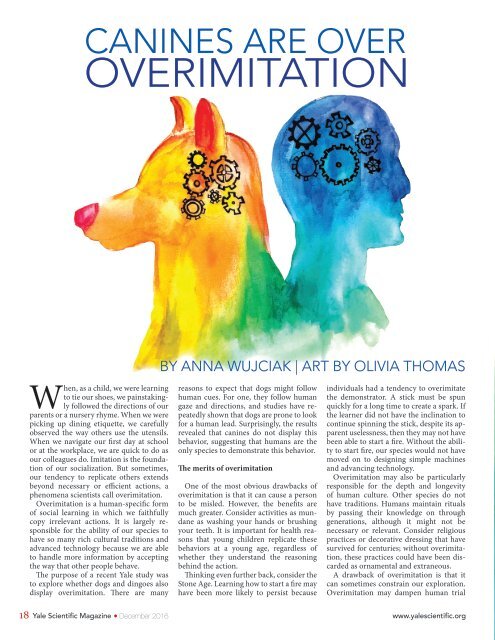YSM Issue 90.1
Create successful ePaper yourself
Turn your PDF publications into a flip-book with our unique Google optimized e-Paper software.
CANINES ARE OVER<br />
OVERIMITATION<br />
BY ANNA WUJCIAK | ART BY OLIVIA THOMAS<br />
When, as a child, we were learning<br />
to tie our shoes, we painstakingly<br />
followed the directions of our<br />
parents or a nursery rhyme. When we were<br />
picking up dining etiquette, we carefully<br />
observed the way others use the utensils.<br />
When we navigate our first day at school<br />
or at the workplace, we are quick to do as<br />
our colleagues do. Imitation is the foundation<br />
of our socialization. But sometimes,<br />
our tendency to replicate others extends<br />
beyond necessary or efficient actions, a<br />
phenomena scientists call overimitation.<br />
Overimitation is a human-specific form<br />
of social learning in which we faithfully<br />
copy irrelevant actions. It is largely responsible<br />
for the ability of our species to<br />
have so many rich cultural traditions and<br />
advanced technology because we are able<br />
to handle more information by accepting<br />
the way that other people behave.<br />
The purpose of a recent Yale study was<br />
to explore whether dogs and dingoes also<br />
display overimitation. There are many<br />
reasons to expect that dogs might follow<br />
human cues. For one, they follow human<br />
gaze and directions, and studies have repeatedly<br />
shown that dogs are prone to look<br />
for a human lead. Surprisingly, the results<br />
revealed that canines do not display this<br />
behavior, suggesting that humans are the<br />
only species to demonstrate this behavior.<br />
The merits of overimitation<br />
One of the most obvious drawbacks of<br />
overimitation is that it can cause a person<br />
to be misled. However, the benefits are<br />
much greater. Consider activities as mundane<br />
as washing your hands or brushing<br />
your teeth. It is important for health reasons<br />
that young children replicate these<br />
behaviors at a young age, regardless of<br />
whether they understand the reasoning<br />
behind the action.<br />
Thinking even further back, consider the<br />
Stone Age. Learning how to start a fire may<br />
have been more likely to persist because<br />
individuals had a tendency to overimitate<br />
the demonstrator. A stick must be spun<br />
quickly for a long time to create a spark. If<br />
the learner did not have the inclination to<br />
continue spinning the stick, despite its apparent<br />
uselessness, then they may not have<br />
been able to start a fire. Without the ability<br />
to start fire, our species would not have<br />
moved on to designing simple machines<br />
and advancing technology.<br />
Overimitation may also be particularly<br />
responsible for the depth and longevity<br />
of human culture. Other species do not<br />
have traditions. Humans maintain rituals<br />
by passing their knowledge on through<br />
generations, although it might not be<br />
necessary or relevant. Consider religious<br />
practices or decorative dressing that have<br />
survived for centuries; without overimitation,<br />
these practices could have been discarded<br />
as ornamental and extraneous.<br />
A drawback of overimitation is that it<br />
can sometimes constrain our exploration.<br />
Overimitation may dampen human trial<br />
18 Yale Scientific Magazine December 2016 www.yalescientific.org


















